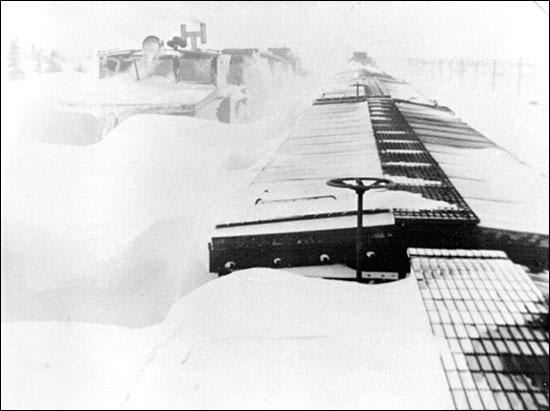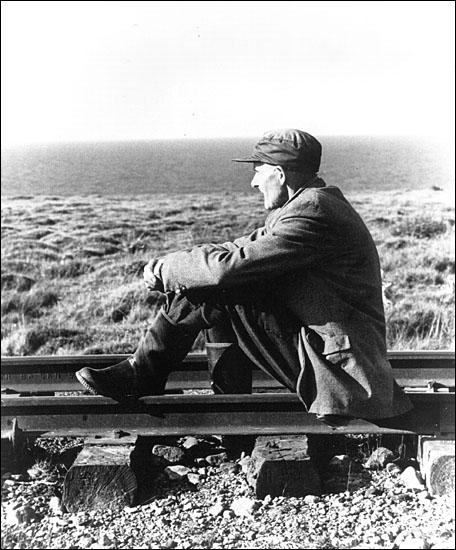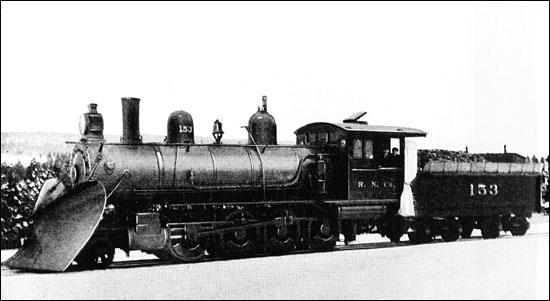Railway Operations and Equipment
It was anticipated from the first that the circumstances of the Colony would not allow for the construction of a railway that would be "first class" by North American standards. In 1880 the House of Assembly's railway committee had recommended the construction of a narrow-gauge line, and this recommendation was incorporated in the act which authorized the letting of a construction contract.
Characteristics of the Railway
The 3'6" gauge was one of the defining features of the Newfoundland railway (standard gauge being 4'8"). Narrow gauge was cheaper to build and had some advantages in difficult terrain. The lay of the land across Newfoundland posed some real obstacles to railway construction (and subsequently to operations as well). The courses of rivers and valleys ran roughly southwest to northeast, making for a ruling grade every 20 miles. The initial targeted maximum grade of 1-1.2 percent was all to frequently doubled, to 2.5 percent. Curvatures of 12-14 degrees were all too common, much greater than on a standard-gauge line. Both these factors curtailed the amount of freight that could be safely hauled, and meant that the cost of converting to standard gauge (as was considered after Confederation and briefly revived in 1980) would entail a prohibitive rebuilding of the line.
It was also a government decision, taken in 1892 and incorporated into R.G. Reid's construction contract in 1893, that the railway should proceed to the west coast by the most direct route, over the Gaff Topsail. This direct route reduced initial construction costs, but the elevation and barrenness of this section necessitated an annual, costly winter battle to keep the line open - and indeed some years the battle was lost. Longtime railwayman A.R. Penney wrote bluntly that "The direct route over the Gaff Topsail was feasible but it was certainly not practicable. The railway should never have been built there."

A third enduring characteristic of railway operations in Newfoundland was a lack of traffic. Although a route across the thinly populated interior of the Island fulfilled the mandate that the line be a "development road", the volume of freight and passenger traffic remained too small to allow for an operating profit. Rates had been set in the 1901 operating contract and there was little political will to permit the contract to be reopened. Of course the volume of traffic was also a reflection of the small and dispersed population of Newfoundland - low volume equally plagued the connecting coastal steamer service, which always required subsidy to operate. The addition of branch lines to the system in 1909-1917 further saddled the railway with additional trackage to be maintained in areas that there was no hope of enough traffic to pay. Penney estimates that operations lost $100,000 yearly 1901-1910, and that the branch lines quickly doubled operating losses.
H.D. Reid Takes Control
The year 1917 was a watershed for the Reid Newfoundland Company. The removal of W.D. Reid by his brother arose from a determination to face a deteriorating situation. While operating losses had been temporarily offset by the profit from branch-line construction, this program had to be abandoned due to the demands on both the line, the public purse, and materials caused by World War I. Further, the deferring of maintenance during wartime, and a serious post-war slump in the economy, led quickly to a crisis.
Under H.D. Reid, some improvements in operations were begun. In 1919, in large part to increase efficiency in winter operations over the Topsail, the line had been divided operationally into Eastern and Western divisions, headquartered in St. John's and Bishops Falls respectively. (The two divisions continued until 1947, when the operating department at St. John's once more assumed responsibility over the whole line.)
But operating losses increased drastically after the war, doubling from $340,000 to $680,000 in 1918-1919, and very nearly doubling again, to $1,300,000 in 1920. In that year the government accepted H.D. Reid's insistence that suspension of operations was imminent, and agreed to joint operation by a six-man committee of the Reid Newfoundland Company and government representatives. Over the next three years, with joint operation being several times extended and/or modified, the committee raised some funds for vital improvements to motive power (ordering six new locomotives of the "Pacific" type), and skeleton maintenance.
Then, in 1923, the government took over the railway from the Reid Newfoundland Company, replacing the joint committee with a Board of Railway Commissioners composed of government members. H.J. Russell, a young Newfoundlander who had extensive experience under the Reid regime, was appointed general manager, remaining in this position until Confederation (and his coincident death in 1949). With the suspension of Responsible Government in 1934, the railway came under the Commissioner for Public Utilities.

Motive Power
The first engines used on the Newfoundland railway were purchased from the narrow-gauge Prince Edward Island Railway in 1881, and were of the Hunslett 4-4-0 tender type. Later, several of the 2-6-0 tender type were purpose-built in England, notably by Hawthorne Leslie of Leeds. After R.G. Reid contracted to build the Halls Bay Railway in 1890, he purchased several other locomotives of the 4-4-0 and 2-6-0 types from Baldwin Locomotive Works of Philadelphia.
Under the 1901 contract, the Reid headquarters and shops were relocated in 1903 from Whitbourne to Riverhead, St. John's, near the new west end terminal. There the Reid Newfoundland Company built its own cars and some motive power, with parts and running gear supplied by Baldwin, particularly, between the beginning of branch line construction in 1909 and World War I. Two "150-class" engines were built at St. John's (primarily for freight) and ten of the smaller "100-class" for use on the branches. Steam rotary plow #3 was also built at the Reid shops.

A program of upgrading motive power was begun in 1920, under joint Reid/government management. These 4-6-2 "190-class" Pacific engines were the workhorses of the Newfoundland railway in the 1920s. In the first years of the wholly-government operation, in effort to provide passenger service at reduced cost on the branch lines and for excursion/commuter service at St. John's and Corner Brook, five self-propelled steam rail cars were added. These "day coaches" remained in operation until the branch line closures of the 1930s.
The steam engines that loom largest in living memory are the "1000-class" 2-8-2 Mikado type, the first of which was acquired in 1930 and the last, #1024, in 1949. Five were acquired from the U.S. government in 1941 under lend-lease. The majority of the 1000-class were converted from coal- to oil-burning, but were scrapped in 1957 to be replaced by diesel electric. Dieselization began in 1952 and was completed by 1960. In those years 53 diesel locomotives were purchased from G.E. of London, Ontario - 26 arriving in December of 1956 - which remained the motive power for the Newfoundland Railway until closure in 1988. Most were 1200 hp engines of the "900-class," with a few of the 800 hp "800-class" for use on the branch lines.




